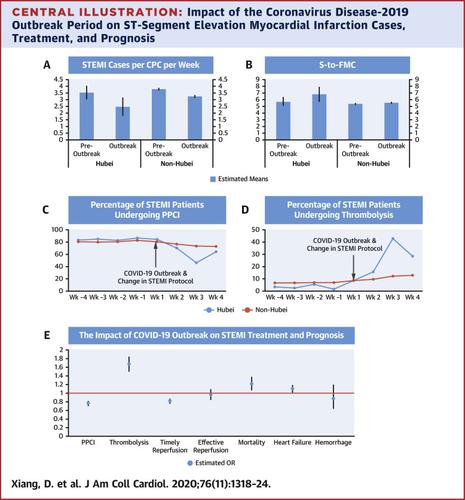当前位置:
X-MOL 学术
›
J. Am. Coll. Cardiol.
›
论文详情
Our official English website, www.x-mol.net, welcomes your
feedback! (Note: you will need to create a separate account there.)
Management and Outcomes of Patients With STEMI During the COVID-19 Pandemic in China
Journal of the American College of Cardiology ( IF 21.7 ) Pub Date : 2020-09-01 , DOI: 10.1016/j.jacc.2020.06.039 Dingcheng Xiang 1 , Xin Xiang 2 , Wei Zhang 3 , Shaodong Yi 1 , Jinxia Zhang 1 , Xiaolong Gu 1 , Yawei Xu 4 , Kai Huang 5 , Xi Su 6 , Bo Yu 7 , Yan Wang 8 , Weiyi Fang 9 , Yong Huo 10 , Junbo Ge 11
Journal of the American College of Cardiology ( IF 21.7 ) Pub Date : 2020-09-01 , DOI: 10.1016/j.jacc.2020.06.039 Dingcheng Xiang 1 , Xin Xiang 2 , Wei Zhang 3 , Shaodong Yi 1 , Jinxia Zhang 1 , Xiaolong Gu 1 , Yawei Xu 4 , Kai Huang 5 , Xi Su 6 , Bo Yu 7 , Yan Wang 8 , Weiyi Fang 9 , Yong Huo 10 , Junbo Ge 11
Affiliation

|
Abstract Background ST-segment elevation myocardial infarction (STEMI) is a fatal cardiovascular emergency requiring rapid reperfusion treatment. During the coronavirus disease-2019 (COVID-19) pandemic, medical professionals need to strike a balance between providing timely treatment for STEMI patients and implementing infection control procedures to prevent nosocomial spread of COVID-19 among health care workers and other vulnerable cardiovascular patients. Objectives This study evaluates the impact of the COVID-19 outbreak and China Chest Pain Center’s modified STEMI protocol on the treatment and prognosis of STEMI patients in China. Methods Based on the data of 28,189 STEMI patients admitted to 1,372 Chest Pain Centers in China between December 27, 2019 and February 20, 2020, the study analyzed how the COVID-19 outbreak and China Chest Pain Center’s modified STEMI protocol influenced the number of admitted STEMI cases, reperfusion strategy, key treatment time points, and in-hospital mortality and heart failure for STEMI patients. Results The COVID-19 outbreak reduced the number of STEMI cases reported to China Chest Pain Centers. Consistent with China Chest Pain Center’s modified STEMI protocol, the percentage of patients undergoing primary percutaneous coronary intervention declined while the percentage of patients undergoing thrombolysis increased. With an average delay of approximately 20 min for reperfusion therapy, the rate of in-hospital mortality and in-hospital heart failure increased during the outbreak, but the rate of in-hospital hemorrhage remained stable. Conclusions There were reductions in STEMI patients’ access to care, delays in treatment timelines, changes in reperfusion strategies, and an increase of in-hospital mortality and heart failure during the COVID-19 pandemic in China.
更新日期:2020-09-01









































 京公网安备 11010802027423号
京公网安备 11010802027423号